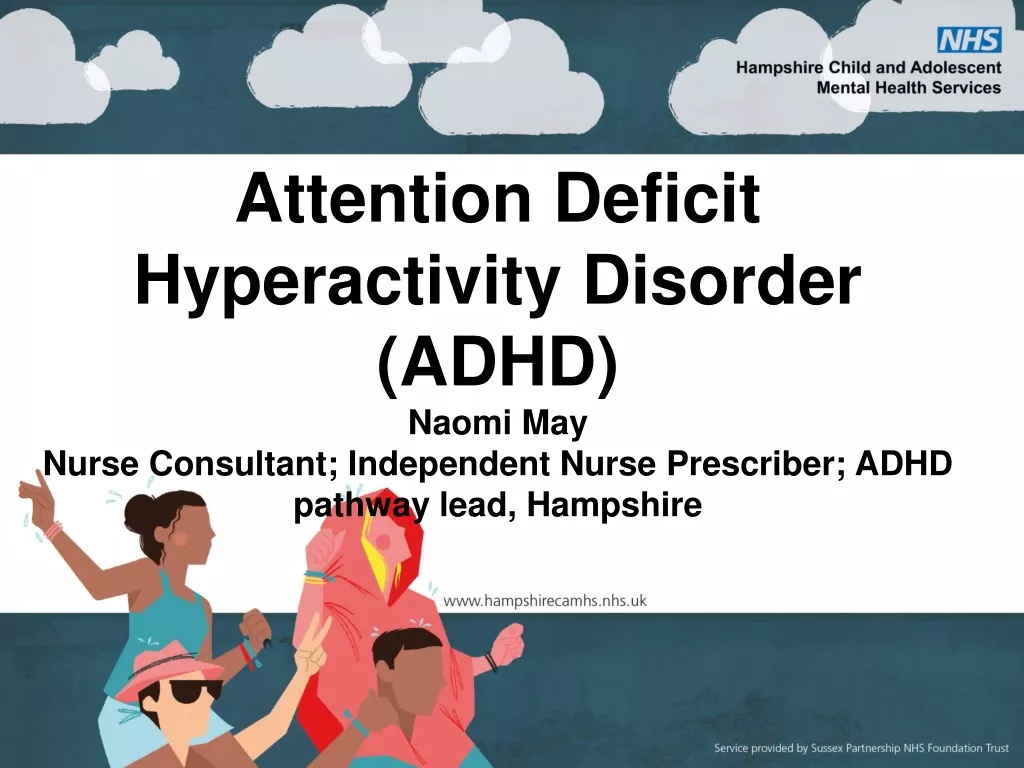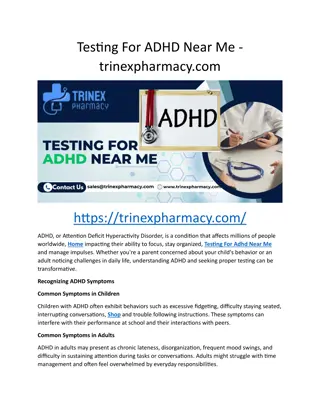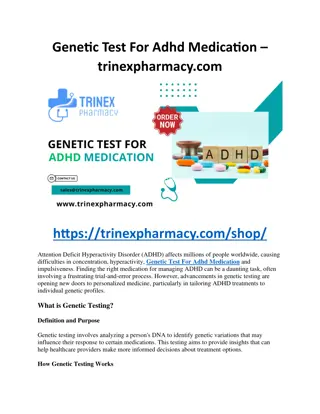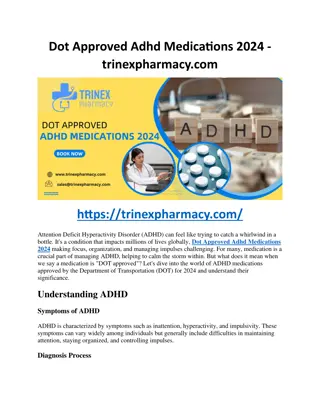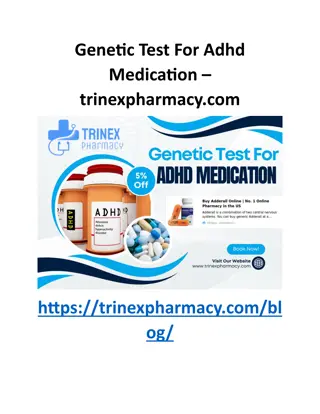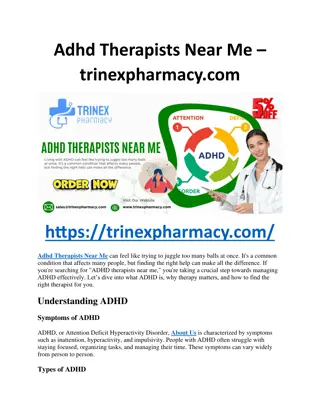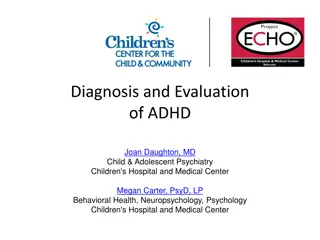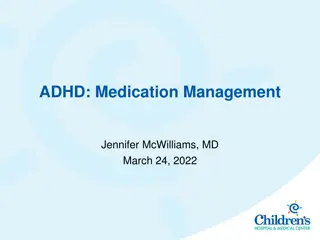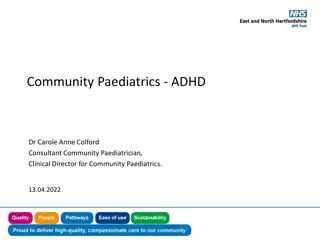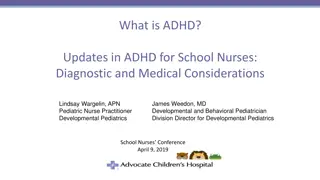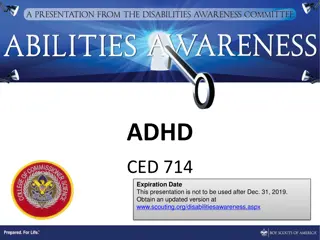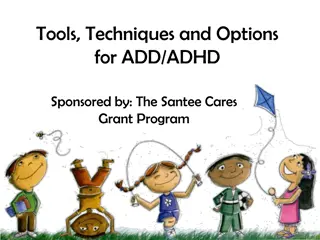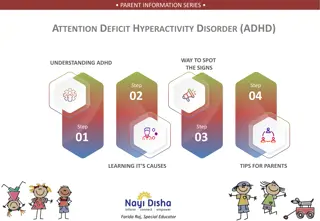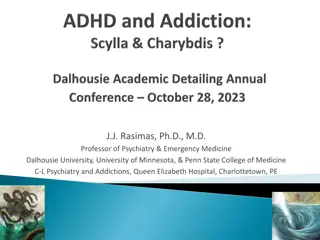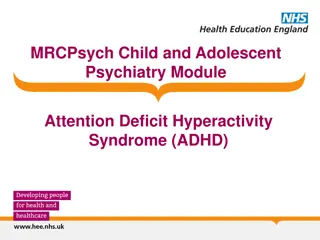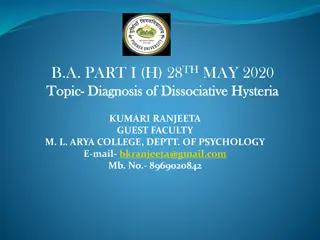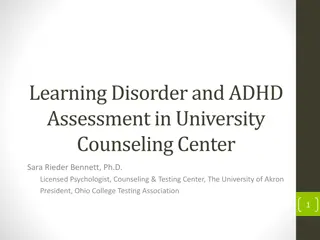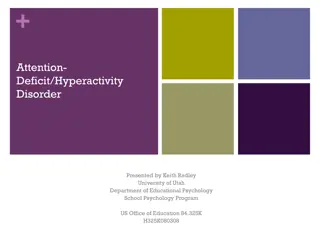ADHD: Symptoms, Diagnosis, and Epidemiology
Attention-deficit hyperactivity disorder (ADHD) is a syndrome characterized by inattention, distractibility, overactivity, and impulsiveness. The DSM-5 criteria for ADHD diagnosis have evolved, emphasizing age-specific symptom onset and specifier categories. Rates of ADHD vary among different age groups, with a higher prevalence in boys. Genetic and environmental factors play a role in the development of ADHD, impacting first-degree biological relatives as well.
Download Presentation

Please find below an Image/Link to download the presentation.
The content on the website is provided AS IS for your information and personal use only. It may not be sold, licensed, or shared on other websites without obtaining consent from the author.If you encounter any issues during the download, it is possible that the publisher has removed the file from their server.
You are allowed to download the files provided on this website for personal or commercial use, subject to the condition that they are used lawfully. All files are the property of their respective owners.
The content on the website is provided AS IS for your information and personal use only. It may not be sold, licensed, or shared on other websites without obtaining consent from the author.
E N D
Presentation Transcript
ADHD SARA DEHBOZORGI
DEFINITION Attention-deficit hyperactivity disorder (ADHD) is a syndrome of: inattention distractibility restless overactivity impulsiveness other deficits of executive function It involves impairment of the ability to plan your work and work your plan.
DSM-5 diagnosis: DSM-5 has made several changes to the diagnostic criteria of ADHD in youth and in adults. Whereas in the past, ADHD symptoms had to be present by age 7 years, in DSM-5, must be present by age 12 years. Previously, there were two subtypes: Inattentive and Hyperactive/Impulsive type. In DSM-5, subtypes have been replaced by the following three specifiers : (1) combined presentation, (2) predominantly inattentive presentation, and (3) predominantly hyperactive/impulsive presentation. Additional changes in DSM-5 include permitting a comorbid ADHD and autism spectrum diagnosis to be made. Finally, in DSM-5, for adolescents 17 years and older and for adults, only 5 symptoms, rather than 6 symptoms of either inattention or hyperactivity and impulsivity are required. In addition, to reflect the developmental differences in ADHD across the life span, examples of symptoms have been added to the DSM-5 criteria for ADHD.
It can be full expression (combined typeDSM-IV (1) or combined presentation DSM-5, with six symptoms from each list of nine) (2) or partial expression (inattentive or hyperactive-impulsive types or presentations, with six symptoms from one of the lists). It is not necessary to have all the symptoms to qualify for the diagnosis.
Epidemiology Rates of ADHD have been reported to be 7 to 8 percent in prepubertal elementary school children. studies suggest that ADHD occurs in about 5 percent of youth including children and adolescents, and about 2.5 percent of adults. The rate of ADHD in parents and siblings of children with ADHD is 2 to 8 times greater than in the general population. ADHD is more prevalent in boys than in girls, with the ratio ranging from 2:1 to as high as 9:1.
First-degree biological relatives are at high risk for developing ADHD as well as other psychiatric disorders, including disruptive behavior disorders, anxiety disorders, and depressive disorders. Siblings of children with ADHD are also at higher risk than the general population for learning disorders and academic difficulties. The parents of children with ADHD show an increased incidence of substance use disorders.
Symptoms of ADHD are often present by age 3 years, but unless they are very severe, the diagnosis is frequently not made until the child is in kindergarten, or elementary school, when teacher information is available comparing the index child peers of the same age.
Etiology Data suggest that the etiology of ADHD is largely genetic, with a heritability of approximately 75 percent. In some cases, contributory factors for ADHD may include prenatal toxic exposures, prematurity, and prenatal mechanical insult to the fetal nervous system. Food additives, colorings, preservatives, and sugar have been proposed as possible contributing causes of hyperactive behavior; however, studies have not confirmed these theories. There is no clear evidence that omega-3 fatty acids are beneficial in the treatment of ADHD.
Genetic Factors Family studies and population-based studies have found an association between the dopamine 4 receptor seven- repeat allele gene (DRD4) gene and ADHD. Most molecular research on ADHD has focused on genes that influence the metabolism or action of dopamine.
Neurochemical Factors Dopamine is a major focus of clinical investigation, and the prefrontal cortex has been implicated based on its role in attention and regulation of impulse control. Animal studies have shown that other brain regions such as locus ceruleus, which consists predominantly of noradrenergic neurons, also play a major role in attention. The noradrenergic system includes the central system (originating in the locus ceruleus) and the peripheral sympathetic system. Dysfunction in peripheral epinephrine, which causes the hormone to accumulate peripherally, may potentially feed back to the central system and reset the locus ceruleus to a lower level.
Disruption of dopamine regulation in fronto-striatal circuit leads to decreased dopamine release & blunted response of receptors, resulting in behavioral presentation seen in ADHD.
Neurophysiological Factors EEG studies in ADHD over the last several decades have found evidence of increased theta activity, especially in the frontal regions. Further studies of youth with ADHD have provided data showing elevated beta activity in their EEG studies. Clarke and colleagues found that those ADHD children with combined type of ADHD were the ones who showed significantly elevated beta activity on EEG, and further studies indicate that these youth also tend to show increased mood lability and temper tantrums.
Neuroanatomical Aspects Researchers describe neuroanatomical correlations for the superior and temporal cortices with focusing attention; external parietal and corpus striatal regions with motor executive functions; the hippocampus with encoding of memory traces; and the prefrontal cortex with shifting from one stimulus to another. Further hypotheses suggest that the brainstem, which contains the reticular thalamic nuclei function, is involved in sustained attention.
Imaging studies suggests that populations of children with ADHD show evidence of both decreased volume and decreased activity in prefrontal regions, anterior cingulated, globus pallidus , caudate,thalamus, and cerebellum. PET scans have also shown that female adolescents with ADHD have globally lower glucose metabolism than both control female and male adolescents without ADHD. One theory postulates that the frontal lobes in children with ADHD do not adequately inhibit lower brain structures, an effect leading to disinhibition.
These areas were demonstrated to normalize with age as well as with stimulant medication treatment. Developmentally, children with ADHD have a 3- to 5-years delay in cortical thickness maturation, particularly in the frontal and temporal brain regions.
Developmental Factors Higher rates of ADHD are present in children who were born prematurely and whose mothers were observed to have maternal infection during pregnancy. Perinatal insult to the brain during early infancy caused by infection, inflammation, and trauma may, in some cases, be contributing factors in the emergence of ADHD symptoms. Children with ADHD have been observed to exhibit nonfocal (soft) neurological signs at higher rates than those in the general population. literature indicate that September is a peak month for births of children with ADHD with and without comorbid learning disorders. The implication is that prenatal exposure to winter infections during the first trimester may contribute to the emergence of ADHD symptoms in some susceptible children.
Psychosocial Factors Severe chronic abuse, maltreatment, and neglect are associated with certain behavioral symptoms that overlap with ADHD including poor attention and poor impulse control.
Clinical Features Infants with ADHD are active in the crib, sleep little, and cry a great deal. In school, children with ADHD may attack a test rapidly, but may answer only the first two questions. They may be unable to wait to be called on in school and may respond before everyone else. At home, they cannot be put off for even a minute. Impulsiveness and an inability to delay gratification are characteristic. Children with ADHD are often susceptible to accidents.
The most cited characteristics of children with ADHD, in order of frequency, are hyperactivity, attention deficit (short attention span, distractibility, perseveration, failure to finish tasks, inattention, poor concentration), impulsivity (action before thought, abrupt shifts in activity, lack of organization, jumping up in class), memory and thinking deficits, specific learning disabilities, and speech and hearing defects. Associated features often include perceptual motor impairment, emotional lability , and developmental coordination disorder. A significant percent of children with ADHD show behavioral symptoms of aggression and defiance. School difficulties, both learning and behavioral, commonly exist with ADHD.
Deficits in ADHD ADHD has been associated with poor inhibitory control, assessed principally with go/no-go and stop signal tasks . Other deficits must play a role in ADHD and include inability to delay response to reward. ADHD is associated with delay aversion (a negative affective state induced by delay cues) and that escape from delay is a primary motivator for ADHD behavior.
Response Inhibition The capacity to think before you act; the capacity to delay or inhibit responding based on the ability to evaluate multiple factors.
EXECUTIVE FUNCTIONS: The ability to maintain an appropriate problem solving set for attainment of a future goal. In cognitive psychology: Executive processes are the part of the cognition that logically must occur after perception but before action. Executive functions are broadly defined as a collection of correlated but highly separable higher order supervisory control processes involved in the flexible production and regulation of complex goal-directed problem-solving thoughts and actions, particularly in nonroutine situations.
Working Memory The ability to hold information in mind while performing complex tasks. It incorporates the ability to draw on past learning or experience to apply to the situation at hand or project into the future.
Self Regulation of Affect The ability to manage emotions in order to achieve goals, complete tasks, or control and direct behavior. Regulation of emotion is the ability to respond to the ongoing demands of experience with the range of emotions in a manner that is socially tolerable and sufficiently flexible as well as the ability to delay spontaneous reactions as needed.
Emotional regulation is a complex process that involves initiating, inhibiting, or modulating one's state or behavior in a given situation for example the subjective experience (feelings), cognitive responses (thoughts), physiological responses (heart rate), and emotion-related behavior (bodily actions).
The process model of emotion regulation occurs in a particular sequence over time. This sequence occurs as follows: Situation: the sequence begins with a situation (real or imagined) that is emotionally relevant. Attention: attention is directed towards the emotional situation. Appraisal: the emotional situation is evaluated and interpreted. Response: emotional response behavioral, and physiological response.
Task Initiation The ability to begin a task without undue procrastination, in a timely fashion.
Time Management The capacity to estimate, allocate, and execute within time constraints. Time management is a higher-level executive skill that includes a number of components such as the ability to follow and make a schedule, to plan and organize, to estimate how long it takes to complete tasks, and to monitor progress in the course of completing tasks. youngsters with poor time management skills tend to lack not only the ability to estimate how long it takes to do something but also lack a sense of time urgency-or the concept that something needs to be completed in a timely and efficient manner.
Planning The ability to create a roadmap to reach a goal or to complete a task. It also involves being able to make decisions about what's important to focus on and what's not important.
Organization The ability to arrange or place things according to a system.
Goal-Directed Persistence The capacity to have a goal, follow through to the completion of the goal, and not be put off by or distracted by competing interests.
Flexibility The ability to revise plans in the face of obstacles, setbacks, new information, or mistakes. It relates to an adaptability to changing conditions.
Metacognition The ability to stand back and take a bird's-eye view of oneself in a situation. It is an ability to observe how you solve the problem. It also includes self-monitoring and self-evaluative skills (e.g., asking yourself, "How am I doing?" or "How did I do?").
ADHD children think after acting rather than before. The deficit is not in thinking but in waiting large enough to give thinking a chance to occur and to then affect responding .
Diagnosis The principal signs may be elicited on the basis of a history of a child s early developmental patterns along with direct observation of the child, especially in situations that require sustained attention. Hyperactivity may be more severe in some situations (e.g., school) and less marked in others (e.g., one-on-one interviews), and may be less obvious in pleasant structured activities (sports). The diagnosis of ADHD requires persistent, impairing symptoms of either hyperactivity/impulsivity or inattention in at least two different settings.
School history and teachers reports are critical in evaluating whether a child s diffiulties in learning and school behavior are caused primarily by inattention or compromised understanding of the academic material. In addition to intellectual limitations, poor performance in school may result from maturational problems, social rejection, mood disorders, anxiety, or poor self-esteem due to learning disorders.
Assessment of social relationships with siblings, peers, and adults, and engagement in free and structured activities may yield diagnostic clues to the presence of ADHD. The mental status examination in a given child with ADHD who is aware of his or her impairment may reflect a demoralized or depressed mood; however, thought disorder or impaired reality testing is not expected.
A neurological examination may reveal visual, motor, perceptual, or auditory discriminatory immaturity or impairments without overt signs of visual or auditory disorders. Children with ADHD often have problems with motor coordination and difficulty copying age-appropriate figures, rapid alternating movements, right left discrimination, ambidexterity, reflex asymmetries, and a variety of subtle nonfocal neurological signs (soft signs). If there are indications of possible absence spells, clinicians should obtain a neurological consultation and an EEG to rule out seizure disorders.
ADHD Rating Scale
1 . 2 . 3 . 4 . 5 . 6 . 7 ) . ( 8 . 9 . 10 . 11 . 12 . 13 . 14 . 15 . 16 . 17 . 18 .
Pathology and Laboratory Examination Medical problems that may produce symptoms overlapping with ADHD include petit mal epilepsy, hearing and visual impairments, thyroid abnormalities, and hypoglycemia. A thorough cardiac history should be taken, including an investigation of the lifetime history of syncope, family history of sudden death, and a cardiac examination of the child. Although it is reasonable to obtain an electrocardiography (ECG) study prior to treatment, if any cardiac risk factors are present, a cardiology consultation and examination are warranted. No specific laboratory measures are pathognomonic of
Differential Diagnosis A temperamental constellation of high activity level and short attention span, in the normal range for the child s age, and without impairment, should be ruled out. Differentiating these temperamental characteristics from the cardinal symptoms of ADHD before the age of 3 years is difficult. Anxiety can accompany ADHD as a symptom or comorbid disorder, and anxiety can manifest with overactivity and easy distractibility. Mania and ADHD share many core features, such as excessive verbalization, motoric hyperactivity, and high levels of distractibility.
Frequently, oppositional defiant disorder, or conduct disorder and ADHD may coexist, and when that occurs, both disorders are diagnosed. Specific learning disorders of various kinds must also be distinguished from ADHD; a child may be unable to read or do mathematics because of a learning disorder, rather than because of inattention. ADHD often coexists with one learning problems.
Course and Prognosis Symptoms have been shown to persist into adolescence in 60 to 85 percent of cases, and into adult life in approximately 60 percent of cases. The remaining 40 percent of cases may remit at puberty, or in early adulthood. In some cases, the hyperactivity may disappear, but the decreased attention span and impulse-control problems persist. Overactivity is usually the first symptom to remit, and distractibility is the last. ADHD does not usually remit during middle childhood.
In about 60 percent of cases, some symptoms persist into adulthood. Those who persist with the disorder may show diminished hyperactivity but remain impulsive and accidentprone. Although the educational attainments of people with ADHD as a group are lower than those of people without ADHD, early employment histories do not differ from those of people with similar educations.
Overall, the outcome of ADHD in childhood seems to be related to the degree of persistent comorbid psychopathology, especially conduct disorder, social disability, and chaotic family factors. Optimal outcomes may be promoted by ameliorating children s social functioning, diminishing aggression, and improving family situations as early as possible. Persistence is predicted by a family history of the disorder, negative life events, and comorbidity with conduct symptoms, depression, and anxiety disorders.


